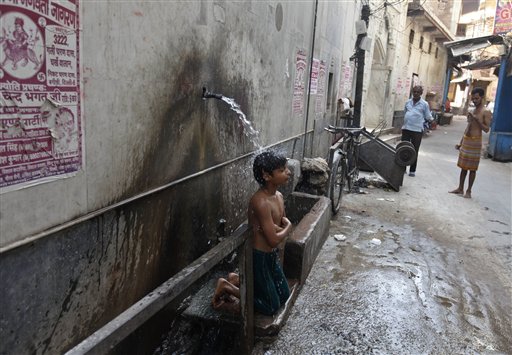For many Americans, it’s as if they’ve been living in Delhi. There’s the suffocating heat, and some Eastern states experienced their own monsoonlike storm last week, complete with lashing winds. When a breeze does whoosh by, it feels the way it does during a midsummer night’s rickshaw ride on the subcontinent, which is to say it feels like a super-powered hair dryer blowing hot air in your face.
This raises the question: How do people cope in places where roasting temperatures aren’t a heat wave, but a way of life? What wisdom do they offer in parts of the world where most people don’t have air conditioning?
“Sudanese try and sleep during the hottest part of the day,” offered Mohaned Kaddam, an Arabic-to-English interpreter who works in the Sudanese capital, Khartoum, preferably during the dawn and dusk hours.
Souks and shops are shuttered throughout most the 110-plus-degree days in Khartoum’s blinding desert sun, reopening at dusk. Summer productivity rises only when the scorching sun sinks.
But in Afghanistan, summer nights are a special time for children, when entire families decamp to the rooftops, catching a breeze if one whispers by.
They all stretch out, atop plush Afghan rugs, and in the moonlight their parents tell them stories about the stars.
“It’s a wonderful time for Afghan children because they learn a lot about astrology and astronomy and sleep above the city,” said Said Jawad, Afghanistan’s ambassador to the United States from 2003 to 2010. Jawad now divides his time between Washington and Kabul.
When he is in Washington, he pumps his AC. When he’s out and about in Kabul, he drinks an Afghan summer tonic called “dough,” his version of which includes 10 percent yogurt, lots of cold water, cubed cucumber, two teaspoons of salt and some fresh mint.
“And this may sound odd, but in northern Afghanistan residents drink hot tea so they can sweat more, which cools them down,” Jawad added. “Plus they can get sick from drinking cold water, which may not be clean.”
In Haiti, they chow down on fried sweet and spicy “banana peppers,” and in Trinidad and Tobago they eat what’s known as “terror peppers.” Both of these allow the body to sweat – a ton – and then cool off.
Even in places not known for sweltering weather, people have ways of dealing with heat waves. When summer warms up Poland, male and female office workers in Warsaw strip down to their knickers and sunbathe in public parks during lunch. In some South American countries, damp sheets are hung in front of the windows of houses. The water evaporates and cools the interior.
Many cultures also report that people simply crack open an icy-cold beer, or two or three. Then they pass out. But aside from sleeping off most of the summer, or kicking it couchside with a brutal hangover, there’s always faith.
In India’s holy – and hot – city of Varanasi, where the summer beats its brutal rays from early April to October and the thermometer hovers around 109, friends advise the following:
• Dress in white flowing cottons. Never, ever tuck your shirt in.
• Sit cross-legged on a puffy white pillow.
• Pray for rain.
In the central Indian city of Amravati, where this year’s summer temperature has climbed to a sweltering 115 degrees, Lalit Khandare, a 33-year-old PhD student in social work, reports that in his hometown, people carry an onion with them; the idea is that it will soak up the heat. Then in the evening they will put the juice of the squashed onion on their palms and feet.
“My mother did this to me,” he added.
Did it work?
“It is very powerful,” he wrote to me on Facebook. “It has immediate cooling effect!”
Because dehydration can be deadly – four people died in May of heat-related illness in the region near Amravati – Indian families also drink unripened mango boiled in water mixed with sugar along with India’s national drink, an effervescent lemon water known as nimbu pani, which is made with freshly squeezed lemons, sugar and salt.
But in a sign that all the white clothing and lemon waters aren’t exactly enough to combat searing heat, the must-have dowry item for the new middle-class bride in India, according to a recent survey in the Indian press, is the mighty air conditioner.
But when the power putters out, there may just be a run on onions.
Emily Wax served as The Washington Post’s correspondent in India and East Africa.
Send questions/comments to the editors.



Success. Please wait for the page to reload. If the page does not reload within 5 seconds, please refresh the page.
Enter your email and password to access comments.
Hi, to comment on stories you must . This profile is in addition to your subscription and website login.
Already have a commenting profile? .
Invalid username/password.
Please check your email to confirm and complete your registration.
Only subscribers are eligible to post comments. Please subscribe or login first for digital access. Here’s why.
Use the form below to reset your password. When you've submitted your account email, we will send an email with a reset code.